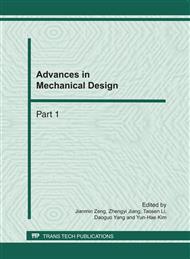[1]
Hall DL, Nauda A. An interactive method for selecting IR&D projects. IEEE Trans Eng Manage; 37(2) (1990): pp.126-33.
DOI: 10.1109/17.53715
Google Scholar
[2]
Martino J P. Research and development project selection. New York: Wiley(1995).
Google Scholar
[3]
ELL IS KV, TANG S L. Wastewater treatment optimization model for developing world. I: Model development [J]. Journal of Environmental Engineering Division, ASCE, 117(1991): pp.501-581.
Google Scholar
[4]
ELL IS KV, TANG S L. Wastewater treatment optimization model for development world. II: Model testing [J]. Journal of Environmental Engineering Division, ASCE, 120(1994): pp.610-624.
DOI: 10.1061/(asce)0733-9372(1994)120:3(610)
Google Scholar
[5]
LIN M, HANG S J. The application of fuzzy decision–making method in the process alternatives of municipal wastewater treatment plant [J]. Water and Wastewater Engineering, 24(3)(1998): pp.6-9. (In Chinese).
Google Scholar
[6]
ZENG GM, JIANG R, HUANG GH, et al. Optimization of wastewater treatment alternatives selection by hierarchy grey relational analysis[J]. Journal of Environmental Management, 82(2007): pp.250-259.
DOI: 10.1016/j.jenvman.2005.12.024
Google Scholar
[7]
WANGL L, ZENG GM, HUANG GH, et al. Study on multi-objective programming for wastewater treatment in small region[J]. Environmental Engineering, 22(6)(2004): pp.88-89. (In Chinese).
Google Scholar
[8]
J.L. Deng. The introduction of grey system. The Journal of Grey System, 1(1) (1989): pp.1-24.
Google Scholar
[9]
Chang NB, Wang SF. A grey nonlinear programming method for planning coastal wastewater treatment and disposal systems [J]. Water Sci &Technol; 32(2) (1995): pp.19-29.
DOI: 10.1016/0273-1223(95)00565-5
Google Scholar
[10]
Huang GH, Baetz BW, Patry GG. Grey integer programming: an application to waste management planning under uncertainty [J]. Eur J Oper Res 1995; 83(1995): pp.594-620.
DOI: 10.1016/0377-2217(94)00093-r
Google Scholar
[11]
Huang GH, Baetz BW, Patry GG. A response to 'a comment on 'Grey integer programming: an application to waste management planning under uncertainty' by Larry Jenkins', [J]. Eur J Oper Res; 100(3) (1997): pp.638-642.
DOI: 10.1016/s0377-2217(97)00081-7
Google Scholar
[12]
J.J. Zhang D.S. Wu,D.L. Olson. The method of grey related analysis to multiple attribute decision making problems with interval numbers[J]. Mathematical and Computer Modeling, 42(9-10)(2005), pp.991-998.
DOI: 10.1016/j.mcm.2005.03.003
Google Scholar
[13]
M.F. Chen G.H. Tzeng. Combining grey relation and TPOSIS concepts for selecting an expatriate host country[J]. Mathematical and Computer Modeling, 40(13)(2004), pp.1473-1490.
DOI: 10.1016/j.mcm.2005.01.006
Google Scholar
[14]
Ming-Lang Tseng. Using linguistic preferences and grey relational analysis to evaluate the environmental knowledge management capacity [J]. Expert Systems with Applications, 37(2010): pp.70-81.
DOI: 10.1016/j.eswa.2009.05.020
Google Scholar
[15]
W.C. Ip ,B.Q. Hu, H. Wong, J. Xia. Applications of grey relational method to river environment quality evaluation in China[J]. Journal of Hydrology, 379 (2009): pp.284-290.
DOI: 10.1016/j.jhydrol.2009.10.013
Google Scholar
[16]
Chen, H., Chang, N. Prediction analysis of solid waste generation based on gray fuzzy dynamic modeling[J]. Resour. Conserv. Recycl. 29 (2000), pp.1-18.
Google Scholar
[17]
Shannon C E. A Mathematical Theory of Communication [J]. Bell System Technical Journal, 27(3) (1948): pp.379-423.
Google Scholar
[18]
Cheng T, Zhang C X. Application of fuzzy AHP based on entropy weight to site selection of solid sanitary landfill[J]. Environmental and Sanitary Engineering, 12(2)(2003): pp.64-67. (in Chinese).
Google Scholar
[19]
Xu S Q, Hu Z G, Liu Q, et al. Multi-objective decision analysis of diversion standards based on entropy [J]. China Rural Water and Hydropower, (8)(2004): pp.45-47. (in Chinese).
Google Scholar
[20]
Wen KL, Chang TC, You ML. The grey entropy and its application in welding analysis. IEEE International Conference on Systems, Man, and Cybernetics 2(1998): pp.1842-1844.
Google Scholar
[21]
Qiu W H. Management decision and applied entropy [M]. Beijing: China Machine Press (2002), pp.193-196. (in Chinese).
Google Scholar
[22]
WANG Zheming, et al. Application of the Gray Interrelated Analysis and Multi-purposes Decision-making Model in Optimization of Project Options[J]. CHINA WATER &WASTEWATER ; 18(1)(2002), pp.81-84. (in Chinese).
Google Scholar


